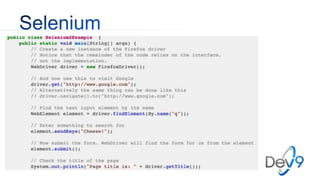

It makes PhantomJS suitable to carry out various page automation tasks. Since the script is executed as if it is running on a web browser, standard DOM scripting and CSS selectors work just fine.

The previous example can be rewritten to: To override this behavior, use the onConsoleMessage callback. Here is an example to show the title of a web page:Īny console message from a web page, including from the code inside evaluate(), will not be displayed by default. An object can be returned from evaluate(), however it is limited to simple objects and can’t contain functions or closures. The execution is "sandboxed", there is no way for the code to access any JavaScript objects and variables outside its own page context. To evaluate JavaScript code in the context of the web page, use evaluate() function. Run the script with the command: phantomjs loadspeed.js The following loadspeed.js script loads a specified URL (do not forget the http protocol) and measures the time it takes to load it.Ĭonsole.log('Usage: loadspeed.js ') Ĭonsole.log('Loading ' + system.args) Ĭonsole.log('Loading time ' + t + ' msec')


It loads and then saves it as an image, example.png in the same directory the script was run in.īecause of its rendering features, PhantomJS can be used to capture web pages, essentially taking a screenshot of the contents. The following script demonstrates the simplest use of page object. It is very important to call phantom.exit at some point in the script, otherwise PhantomJS will not be terminated at all.Ī web page can be loaded, analyzed, and rendered by creating a webpage object. In the second line, phantom.exit terminates the execution. In the first line, console.log will print the passed string to the terminal. Save it as hello.js and then run it from the terminal or command prompt: Hello, World!Ĭreate a new text file that contains the following two lines: This instruction assumes that PhantomJS is installed and placed somewhere in the PATH (e.g. Make sure that you are familiar with the use of the command prompt or PowerShell (on Windows) or a terminal (on macOS and Linux). Quick Start with PhantomJS Quick Start with PhantomJS


 0 kommentar(er)
0 kommentar(er)
